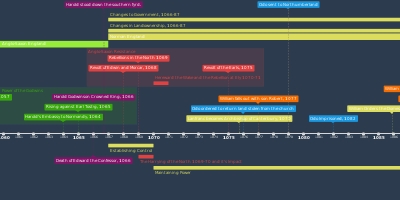Anglo-Saxon England (jan 1, 1042 – dec 25, 1066)
Description:
Social System:-The King
Was the most powerful, made laws, protected the country, upheld justice.
-Earls
Controlled an area of land called an earldom and ruled over thegns.
-Thegns
Owned land directly from the king and gave men for the fyrd.
-Ceorl
Free men that served in the army if called upon and owned their own land.
-Peasant
Worked on a thegns land for several days a week and rented their own land.
-Slaves
Didn't own land and worked for a thegn as a labourer.
People could move up or down the social system depending on their wealth and landholdings.
The Monarchy:
-The king was pious and a respected law-maker.
-Had a powerful military force under his earls and thegns.
-His power was often limited due to the extent of power of his earls.
-The Danelaw also limited his power as they often ignored some Anglo-Saxon customs and laws.
The Witan:
Was a council of advisors to the king who discussed threats and disputes. They decided who the next king of England would be. The king did not have to follow the Witan's advice and chose who the members were.
Earls and Earldoms:
Earls collected taxes, were in charge of justice and punishment. They had great military power and each earl had their own trained soldiers called housecarls.
Local Government:
Earldom-shire-hundred-tithing-hide
The fyrd was the army, made up of one man from every 5 hides. The select fyrd was made up of well-equipped and well-trained thegns and knights who gave the king 40 days of knight service a year.
Shire Reeves collected fines, enforced laws and provided men for the fyrd in each shire.
The Legal System:
Blood feuds were grudges that lasted between families, often for several generations. It meant that if a family member had been killed, then they had the right to kill someone from the murderer's family.
The Wergild system gave compensation for a murder, the amount given increased with social status.
Justice was based on collective responsibility.
The Economy:
-England was well-suited to growing crops and traded wool and cloth with other countries.
-Each shire had a burh which was the main place of trade.
-They would be well fortified and linked by roads.
-Villages consisted of several houses scattered in the countryside. Houses were simple and made of straw and wood, they'd be near a thegn's house and a church.
The Influence of the Church:
-Oragnised into large areas controlled by a bishop who were often rich.
-Local priests weren't well-educated and were often normal people.
-Religion was important in everyday life as many worried what would happen to them when they died.
Added to timeline:
Date:
jan 1, 1042
dec 25, 1066
~ 24 years
